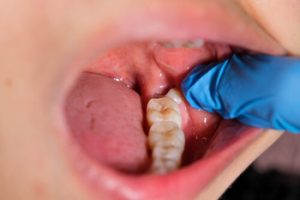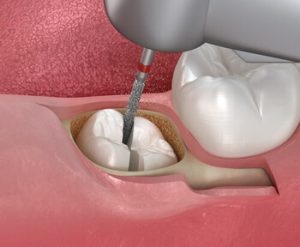If you’ve recently had a wisdom tooth removed and found yourself peering at the tooth socket, you might have asked, “What’s that white stuff in wisdom tooth hole?” You are certainly not alone. Many people notice a white substance forming at the site of an extracted tooth, and while it can look worrying, it is usually a completely normal stage of healing.
In this blog, we will explain the white material, why it happens, and when you should speak to your dentist. Let’s walk through the entire healing journey clearly and reassuringly.
Understanding the Healing Journey After Tooth Extraction
When a wisdom tooth is removed, your body works quickly to repair the wound left behind. This natural healing process is incredibly sophisticated and happens in carefully timed stages. These stages include:
- Formation of a protective blood clot
- Growth of granulation tissue
- Gradual development of new gum tissue
As soon as the tooth extraction procedure is finished, a blood clot forms in the tooth socket. This blood clot is vital because it seals off the nerves and bones underneath and protects them from bacteria, air, and food particles. You can think of it as the body’s built-in bandage, essential for proper healing.
The Role of Granulation Tissue: Your Healing Hero
A few days after your wisdom tooth has been removed, you may notice what people sometimes call tooth extraction healing white stuff in the socket. Most of the time, this is called granulation tissue. Granulation tissue is a vital part of your body’s recovery response and usually appears white, yellowish, or pale.

- New connective tissue
- Tiny blood vessels
- White blood cells
- Special cells that fight infection
This combination works together to protect the wound and help rebuild the gum tissue. The new blood vessels carry nutrients and oxygen, while the white blood cells fight off harmful bacteria. Overall, this tissue creates a scaffold for new gum to grow over and close the wound left by the extracted tooth.
Seeing this white substance is generally a healthy sign that your healing process is on track.
Blood Clot vs White Stuff: Spotting the Difference
In the first 24 hours after a tooth extraction, the blood clot is the star of the show. It is usually dark red and jelly-like. But as the days go on, this clot slowly transforms as healing progresses. It becomes covered by granulation tissue, which looks pale or white.
So, if you see the white substance after a few days, there is no need to worry. It is just your body working hard to heal.
But What if You Feel Pain?
While the white stuff you see in a healing wisdom tooth hole is often granulation tissue, it is worth watching for other warning signs. If you have severe pain or notice a foul taste in your mouth, it might not be normal healing but something more serious, like a dry socket or an infection.
Granulation tissue
- Looks pale, white, or yellowish
- Soft, moist, not crumbly
- No bad odour
- Mild tenderness only
Dry socket
- Severe, throbbing pain
- Bad breath or foul taste
- Empty-looking tooth socket
- Visible bone with no protective blood clot
- Swelling and gum inflammation
A dry socket develops when the protective blood clot is lost too soon or never forms properly. This leaves the sensitive bone and nerves exposed, leading to intense pain a few days after the tooth was extracted. If you suspect a dry socket, get in touch with your dentist straight away.
Could It Be Just Food Debris?
There is also a chance that the white material you see is not granulation tissue at all but trapped food debris. Because the tooth extraction site is an open wound, bits of food can easily collect inside, especially when you stick to soft foods.
Food debris is usually:
- Crumbly
- Sometimes smells bad
- It may cause mild discomfort
You can gently rinse your mouth with warm salt water after meals to help remove any leftover food particles from the tooth socket. This also supports proper healing and helps keep harmful bacteria away.
Encouraging Healthy Healing After a Tooth Extraction

- Eat soft foods for the first few days
- Stay away from smoking or drinking through straws
- Rinse gently with warm salt water after the first day
- Brush gently around the area without disturbing the blood clot
- Follow your dentist’s aftercare instructions
These steps help protect the healing tissue and allow the blood clot and granulation tissue to stabilise. That is the best way to promote a smooth recovery and prevent dry socket or other complications.
Why Does Healing Look White?
It can be unsettling to look at the healing site and see a white or pale layer. However, this is typically a normal part of the healing process. Here is why:
- The granulation tissue is naturally pale because of its high content of new connective tissue and tiny blood vessels
- New gum tissue forming over the site can look white initially
- White blood cells actively fighting bacteria can give a whitish appearance
- Saltwater rinses may leave a temporary pale film
Unless you are experiencing severe pain, swelling, or a bad odour, the extraction healing white stuff you see is generally a healthy sign.
A Week-By-Week Healing Timeline
Healing after having an extracted tooth is different for everyone, but most people follow a similar pattern. Here is a rough outline:
First 24 hours: The blood clot forms
Days 2–5: Granulation tissue starts to appear
Week 1–2: New gum tissue begins to close over the extraction site
Week 2–4: The tooth socket continues to harden and remodel
Remember, even after the gum looks healed on the outside, the bone underneath continues repairing for several weeks. Patience is key.
Can You Speed Up Healing?
There is no miracle to make your gums heal instantly, but you can definitely support the body’s natural repair systems by:
- Eating balanced, nutritious meals
- Staying well hydrated
- Avoiding smoking or alcohol
- Sleeping well
- Keeping the mouth clean with gentle, warm salt water rinses
These habits encourage blood flow to the healing site, helping your white blood cells and blood vessels rebuild the area left by the extracted tooth.
Dry Socket: The Trouble You Want to Avoid
A dry socket is one of the most uncomfortable complications after wisdom teeth removal. When the blood clot fails to protect the bone, the sensitive nerves are left exposed, causing severe pain. A dry socket happens more often with lower wisdom teeth, but it can happen with any extracted tooth.
Symptoms of dry socket include:
- Severe pain that gets worse
- Bad breath or unpleasant taste
- An empty-looking socket with visible bone
- Swelling and gum inflammation
If you have these symptoms, see your dentist right away. They can clean the area and apply a medicated dressing to ease your pain and help restart the body’s healing process.
When to Check With Your Dentist

- Intense pain that does not improve
- Increasing swelling
- Bad taste in your mouth
- Fever or chills
Your dentist will examine the extraction site to check for infection, dry socket, or other complications and make sure your healing is on track.
Final Thoughts: That White Stuff Is Usually a Sign of Healing
In most cases, the white stuff in the wisdom tooth hole is simply part of the natural repair process after a tooth has been removed. Whether you call it extraction healing white stuff or understand it as granulation tissue, it is a reassuring sign that your body is working as it should.
Unless you have severe pain, bad odours, or worrying swelling, the appearance of white tissue in the socket is perfectly normal. Keep looking after your mouth, follow your dentist’s guidance, and give your body time to rebuild the tissue around the extracted tooth.
If you have had your tooth extracted and are feeling in doubt, do not hesitate to check with your dental care professional for peace of mind. Book your dental visit today at (08) 7078 8263 to help you ensure proper healing and a smooth recovery.
Note: Any surgical or invasive procedure carries risks. Before proceeding, you should seek a second opinion from an appropriately qualified health practitioner.
References
- Cleveland Clinic. (n.d.). Dry socket (alveolar osteitis). Retrieved from https://my.clevelandclinic.org/health/diseases/17731-dry-socket
- ScienceDirect. (n.d.). Granulation tissue. Retrieved from https://www.sciencedirect.com/topics/medicine-and-dentistry/granulation-tissue
- Healthline. (n.d.). Salt water rinse for mouth: Benefits and how to do it. Retrieved from https://www.healthline.com/health/dental-and-oral-health/salt-water-rinse

